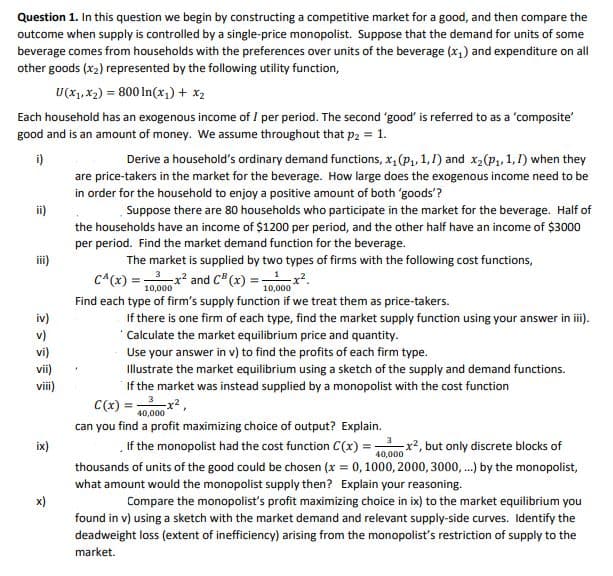outcome when supply is controlled by a single-price monopolist. Suppose that the demand for units of some beverage comes from households with the preferences over units of the beverage (x,) and expenditure on all other goods (x2) represented by the following utility function, U(x1, x2) = 800 In(x,) + x2 Each household has an exogenous income of I1 per period. The second 'good' is referred to as a 'composite' good and is an amount of money. We assume throughout that p2 = 1. i) Derive a household's ordinary demand functions, x, (P,, 1,1) and x2(P, 1,1) when they are price-takers in the market for the beverage. How large does the exogenous income need to be in order for the household to enjoy a positive amount of both 'goods'? ii) Suppose there are 80 households who participate in the market for the beverage. Half of the households have an income of $1200 per period, and the other half have an income of $3000
outcome when supply is controlled by a single-price monopolist. Suppose that the demand for units of some beverage comes from households with the preferences over units of the beverage (x,) and expenditure on all other goods (x2) represented by the following utility function, U(x1, x2) = 800 In(x,) + x2 Each household has an exogenous income of I1 per period. The second 'good' is referred to as a 'composite' good and is an amount of money. We assume throughout that p2 = 1. i) Derive a household's ordinary demand functions, x, (P,, 1,1) and x2(P, 1,1) when they are price-takers in the market for the beverage. How large does the exogenous income need to be in order for the household to enjoy a positive amount of both 'goods'? ii) Suppose there are 80 households who participate in the market for the beverage. Half of the households have an income of $1200 per period, and the other half have an income of $3000
Chapter14: Monopoly
Section: Chapter Questions
Problem 14.9P
Related questions
Question
part 4 5 6

Transcribed Image Text:Question 1. In this question we begin by constructing a competitive market for a good, and then compare the
outcome when supply is controlled by a single-price monopolist. Suppose that the demand for units of some
beverage comes from households with the preferences over units of the beverage (x,) and expenditure on all
other goods (x2) represented by the following utility function,
U(x1, x2) = 800 In(x1) + x2
Each household has an exogenous income of I per period. The second 'good' is referred to as a 'composite'
good and is an amount of money. We assume throughout that p2 = 1.
i)
Derive a household's ordinary demand functions, x, (P, 1,1) and x,(P1, 1, 1) when they
are price-takers in the market for the beverage. How large does the exogenous income need to be
in order for the household to enjoy a positive amount of both 'goods'?
ii)
Suppose there are 80 households who participate in the market for the beverage. Half of
the households have an income of $1200 per period, and the other half have an income of $3000
per period. Find the market demand function for the beverage.
iii)
The market is supplied by two types of firms with the following cost functions,
C^(x) =x2 and C (x) =x.
10,000
10,000
Find each type of firm's supply function if we treat them as price-takers.
If there is one firm of each type, find the market supply function using your answer in iii).
"Calculate the market equilibrium price and quantity.
Use your answer in v) to find the profits of each firm type.
Illustrate the market equilibrium using a sketch of the supply and demand functions.
If the market was instead supplied by a monopolist with the cost function
iv)
v)
vi)
vii)
vii)
C(x) = r2,
40,000
can you find a profit maximizing choice of output? Explain.
If the monopolist had the cost function C(x) -
thousands of units of the good could be chosen (x = 0, 1000, 2000, 3000, .) by the monopolist,
what amount would the monopolist supply then? Explain your reasoning.
3
ix)
x², but only discrete blocks of
40,000
x)
Compare the monopolist's profit maximizing choice in ix) to the market equilibrium you
found in v) using a sketch with the market demand and relevant supply-side curves. Identify the
deadweight loss (extent of inefficiency) arising from the monopolist's restriction of supply to the
market.
Expert Solution
This question has been solved!
Explore an expertly crafted, step-by-step solution for a thorough understanding of key concepts.
Step by step
Solved in 2 steps

Knowledge Booster
Learn more about
Need a deep-dive on the concept behind this application? Look no further. Learn more about this topic, economics and related others by exploring similar questions and additional content below.Recommended textbooks for you

